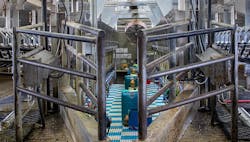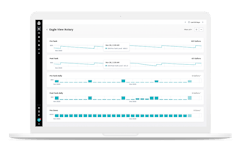The case for remote monitoring as a service
Automated Dairy is an OEM, maintenance and service company supporting dairy operations across the Western United States. With the introduction of their automated TURBOSPRAY system, they implemented equipment monitoring to improve their service team’s efficiency, optimize maintenance and deliver an exceptional customer experience.
- Industrial gateways connect to each system’s PLC and provide remote visibility of the most important parameters for Automated Dairy and their customers, including dip usage, environmental temperatures and cycle count
- Alerts and remote control enable remote troubleshooting and help minimize the cost of truck rolls
- Historical data and analytics support a data-based preventative maintenance program that helps maximize uptime
Headquartered in Southern Idaho, Automated Dairy started as a dairy installation, service and maintenance solution in 1986. Today, with branches across four states and a dedicated research and development division, the company is quickly becoming the leader in dairy service and automation.
Leading the organization's research and development is Jon Higley. As president of Automated Dairy, Higley provides an inside look at the company’s approach to product development and customer service. “We take a customer-first approach in everything we do here at Automated Dairy. That means we spend a lot of time out in the field and down in the trenches always looking for new ways to help dairy families be successful,” says Higley. “That’s what led us to develop our TURBOSPRAY product—we saw a big need among our customers for a way to improve on the teat dip application process.”
Teat dip is a liquid solution that is typically used before and after milking to prevent costly infections, but manual application can be time consuming and inconsistent. TURBOSPRAY streamlines this process, automatically spraying cows as they enter and exit the dairy parlor. This innovative piece of technology ensures consistent application, reduces labor costs and helps dairymen increase their overall throughput.
In their vision for the product, Automated Dairy focused on three guiding principles: simplicity, reliability and consistency. They successfully built a product with no moving parts, avoiding the complex robotics of other automated dip systems. And by including remote monitoring on every unit, Automated Dairy is able to ensure reliable operation by proactively identifying issues and optimizing maintenance across their entire fleet of equipment.
By including remote monitoring on every TURBOSPRAY unit, Automated Dairy is able to ensure reliable operation by proactively identifying issues and optimizing maintenance across their entire fleet of equipment.
Delivering exceptional service with fewer truck rolls
Approaching over 100 sprayers across rural barns in the Western United States, Automated Dairy uses equipment monitoring to maximize the efficiency of their service team.
“With the data we get, we don’t have to send someone out every day to check on the system. We can get a bill of health right on our phones,” says Higley.
One way they use this data is to identify when a TURBOSPRAY system’s dip solution tank is due for a top up. “We’re monitoring how many gallons of dip we have at each dairy and we send out text and email alerts to dispatch our service team when it’s time for a refill,” says Higley. “Ultimately, this helps us ensure that our units are ready to support our customers 24/7.”
In addition to monitoring for dispatch, Automated Dairy uses alerts and control features for remote troubleshooting. Logan Kinghorn, research and development specialist, explains how it works: “Under normal operation, the level of dip solution in each supply tank should decrease at a steady rate. If we see anything other than that, it’s a great indicator that something’s not working. We get alerts on sudden changes in usage and we can trend that data to immediately start diagnosing the problem. For example, if we see a sudden drop, there could be a leak in the system, whereas if the rate is slower than expected, there might be a blocked valve. We’re also able to turn each sprayer on or off and even switch which solution is being sprayed just by flipping a switch from a phone or computer,” Kinghorn says.
Optimizing maintenance with data and analytics
To help maximize uptime, Automated Dairy is also building a data-backed preventive maintenance (PM) plan. “By tracking the number of cows that pass through our system, we can start to understand the average number of cycles a unit goes through before a part needs to be replaced,” says Higley. “Instead of running on a time-based schedule, we can be much more precise and say, ‘Alright, this unit has had 2 million cycles, it’s time to send our service team out for PM to replace the solenoid valve.’"
"This will ultimately help us prevent unplanned downtime and save time on unnecessary service visits.” In addition to the time it saves their team, this will help Automated Dairy better align maintenance and part replacements with their customers’ planned downtime. “Every minute of time we can give back to our customers means greater throughput and more time to complete important work, like barn sanitation,” says Kinghorn. “Being able to schedule a service visit during our customers’ planned downtime is a huge win for us.”
In addition to monitoring for dispatch, Automated Dairy uses alerts and control features for remote troubleshooting. The company is also building a data-backed preventive maintenance plan.
A partner for the long-term
Automated Dairy chose to partner with Samsara because they needed an all-in-one remote monitoring solution that was easy to deploy. “Most of our customers don’t have any sort of network or connectivity in place, and that was a prerequisite for many of the monitoring systems I’ve used before,” says Kinghorn. "The fact that each of the Samsara Industrial Gateways includes cellular connectivity was a huge plus for us."
"We’re able to connect directly to our PLCs and get the visibility we need without having to worry about additional service and hardware costs for a wireless network.”
In addition to meeting their requirements today, Automated Dairy already sees more future applications for Samsara across their product offerings. “Our goal is ultimately to create a single platform for the dairyman, giving them the information they need in real-time, and Samsara is a core part of that,” says Kinghorn. "We’re speaking directly with Samsara’s product and engineering team and we see the same customer-first approach that we strive for with our customers. That’s what gets us really excited about continuing to work together.”
To learn more about Samsara for equipment monitoring or to start a free trial, contact us here.



